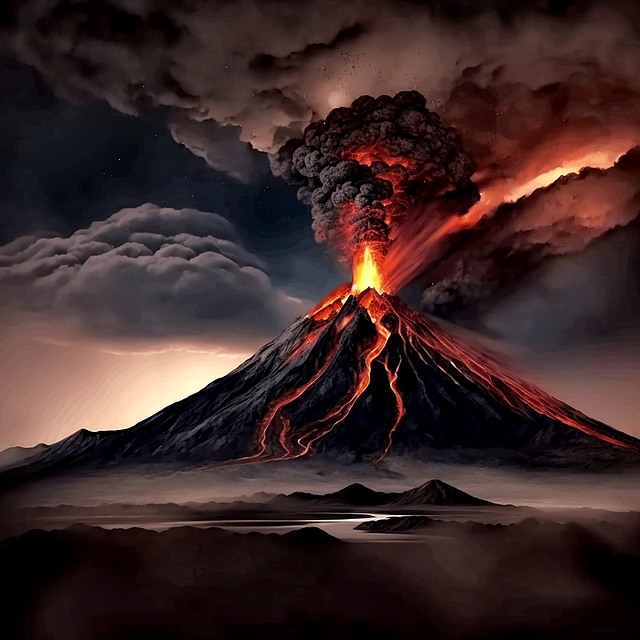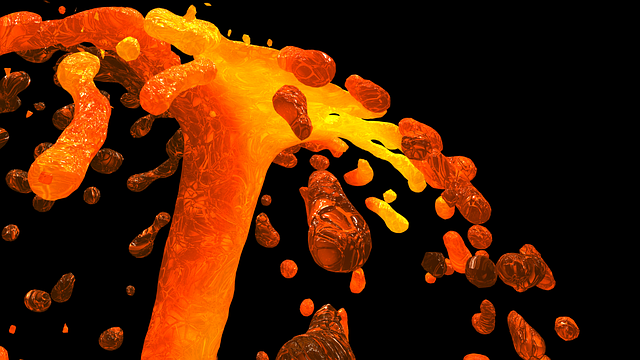Amazing fact: See why volcanoes erupt on mountains

Volcanoes erupt on mountains because mountains often form at the boundaries of tectonic plates, where the Earth’s crust is subject to intense geological activity. If you’ve ever pondered the primal forces that shape our world, buckle up and embark on an odyssey to uncover the truth behind why volcanoes erupt on mountains.
Reasons why volcanoes are commonly found on mountains
Plate Tectonics: Volcanoes often occur at plate boundaries, where tectonic plates either collide (convergent boundaries), move apart (divergent boundaries), or slide past each other (transform boundaries). These interactions can lead to the formation of mountains and the release of magma from beneath the Earth’s crust, resulting in volcanic eruptions.
Subduction Zones: In some cases, one tectonic plate may be forced beneath another in a process called subduction. This creates immense pressure and heat, causing the subducted plate to melt and form magma. This magma can rise through the Earth’s crust, eventually leading to volcanic eruptions on the surface, often associated with mountain ranges formed by the collision of tectonic plates.
Hotspots: Another way volcanoes can form on mountains is through hotspots, which are areas of intense volcanic activity caused by a rising plume of hot mantle material. As tectonic plates move over these hotspots, magma can erupt through the Earth’s crust, forming volcanic islands or mountain chains. A well-known example is the Hawaiian Islands, which were formed by a hotspot beneath the Pacific Plate.
Weak Points in Earth’s Crust: Mountains often have weaknesses or fractures in their crust that can provide pathways for magma to reach the surface. These weaknesses can be created by the geological forces involved in mountain-building processes, such as folding, faulting, and uplift.
Understanding the Phenomenon: Why Volcanoes Erupt on Mountains
To comprehend the eruption of volcanoes on mountains, we must delve into the intricate workings of our planet’s geology. From the formation of mountains to the role of magma, and the triggering factors behind volcanic activity, each aspect contributes to the captivating spectacle of volcanic eruptions.
Volcanoes, often referred to as nature’s fury unleashed, are geological formations where molten rock, ash, and gases escape from beneath the Earth’s surface. These fiery behemoths are symbols of both destruction and creation, shaping landscapes over millions of years.
Anatomy of a Volcano: Peaks of Power
The anatomy of a volcano reveals its inner workings and external features. From the crater at its summit to the magma chamber below, each component plays a crucial role in the eruption process. Understanding this anatomy is key to deciphering the mysteries of volcanic activity.
Formation of Mountains and Volcanoes
The Earth’s Dynamic Crust: A Moving Puzzle
The Earth’s crust is in a constant state of motion, driven by the slow churn of tectonic plates beneath the surface. This dynamic interplay of forces gives rise to mountains and volcanoes, reshaping the landscape over millennia.
Subduction Zones: Where Tectonic Plates Collide
Subduction zones, where one tectonic plate is forced beneath another, are hotspots for volcanic activity. The collision and subsequent melting of rock layers create the ideal conditions for magma to rise to the surface, leading to explosive eruptions.
The Birth of Mountains: Forces Beneath the Surface
Mountains, born from the relentless forces beneath the Earth’s surface, provide the perfect stage for volcanic eruptions. As tectonic plates collide and magma rises, these towering peaks become the focal points of geological activity.
The Role of Magma
Unveiling the Molten Core: The Power of Magma
Magma, the molten rock beneath the Earth’s surface, is the lifeblood of volcanoes. Its relentless force and energy fuel the explosive eruptions that shape our world, leaving behind a trail of destruction and creation.

Magma Chambers: Reservoirs of Destruction
Deep within the Earth, magma chambers act as reservoirs of destruction, storing vast quantities of molten rock until the pressure becomes too great. When these chambers rupture, the resulting volcanic eruptions can have catastrophic consequences.
The Triggering Factors
Pressure Cooker Effect: Building Pressure Beneath the Surface
Volcanic eruptions are often likened to a pressure cooker, with immense forces building beneath the Earth’s surface until they can no longer be contained. The release of this pressure triggers explosive eruptions, unleashing the full fury of nature.
Tectonic Movements: The Earth’s Restless Dance
The restless dance of tectonic plates is a constant reminder of the Earth’s dynamic nature. As plates shift and collide, they create the perfect conditions for volcanic activity, leading to the spectacular eruptions that define our world.
Geological Faults: Cracks in the Earth’s Armor
Geological faults, fractures in the Earth’s crust, provide pathways for magma to reach the surface. When these faults rupture, they unleash the pent-up energy stored beneath the surface, resulting in volcanic eruptions of varying intensity.
Types of Volcanoes
Shield Volcanoes: Gentle Giants or Explosive Threats?
Shield volcanoes, with their gently sloping sides and broad summits, are often seen as the gentle giants of the volcanic world. However, beneath their tranquil exterior lies the potential for explosive eruptions that can reshape entire landscapes.
Stratovolcanoes: The Classic Conical Shape
Stratovolcanoes, with their iconic conical shape, are among the most recognizable volcanic formations. These towering peaks are capable of producing some of the most violent and destructive eruptions in history, leaving behind a legacy of destruction and devastation.
Cinder Cone Volcanoes: The Cinderella of the Volcanic World
Cinder cone volcanoes, characterized by their steep sides and symmetrical shape, are often overlooked in favor of their more imposing counterparts. However, these humble volcanoes have a beauty and elegance all their own, showcasing the raw power of nature in its purest form.
Eruption Mechanisms
Explosive Eruptions: A Spectacle of Power
Explosive eruptions, fueled by the rapid release of gas and magma, are among the most awe-inspiring displays of nature’s power. From towering ash clouds to rivers of molten rock, these eruptions leave an indelible mark on the landscape and imagination.

Effusive Eruptions: The Quiet Fury of Lava Flows
Effusive eruptions, characterized by the slow and steady flow of lava, are a stark contrast to their explosive counterparts. While less dramatic, these eruptions can still wreak havoc on the surrounding landscape, burying everything in their path beneath a river of molten rock.
Volcanic Hazards
Lava Flows: Creeping Destruction
Lava flows, the slow-moving rivers of molten rock unleashed during volcanic eruptions, are a constant threat to life and property. While they may move slowly, their relentless advance can engulf everything in their path, leaving behind a trail of destruction in their wake.
Pyroclastic Flows: A Deadly Avalanche
Pyroclastic flows, fast-moving avalanches of hot gas, ash, and rock fragments, are among the most deadly hazards associated with volcanic eruptions. Traveling at speeds of up to 450 miles per hour, these deadly avalanches can engulf entire towns in a matter of minutes, leaving little behind but devastation and despair.
Ashfall: Blanketing the Landscape
Ashfall, the fine particles of rock and glass ejected during volcanic eruptions, can blanket the landscape for hundreds of miles in every direction. While seemingly innocuous, these tiny particles can wreak havoc on everything they touch, from crops and livestock to the respiratory systems of humans and animals alike.
Monitoring and Predicting Volcanic Activity
Volcanic Monitoring: Keeping a Watchful Eye
Volcanic monitoring plays a crucial role in predicting and mitigating the impact of volcanic eruptions. From seismic sensors to gas detectors, a network of monitoring stations around the world keeps a watchful eye on volcanic activity, providing early warning signs of impending eruptions.
Predicting Eruptions: The Science of Forewarning
Predicting volcanic eruptions is a complex and challenging endeavor, requiring a deep understanding of the forces at play beneath the Earth’s surface. By monitoring seismic activity, gas emissions, and ground deformation, scientists can forecast the likelihood and intensity of future eruptions, giving communities valuable time to prepare and evacuate if necessary.
Conclusion
Volcanoes have captivated human imagination for centuries, shrouded in mystery and awe. They stand as colossal monuments of nature’s power, both majestic and dangerous. But why do these fiery giants choose mountains as their stage for eruption?
While their eruptions can wreak havoc, they also offer valuable insights into the inner workings of our planet. In summary, the geological processes that lead to the formation of mountains are closely linked to volcanic activity, resulting in the common occurrence of volcanic eruptionsgrf on mountains.









